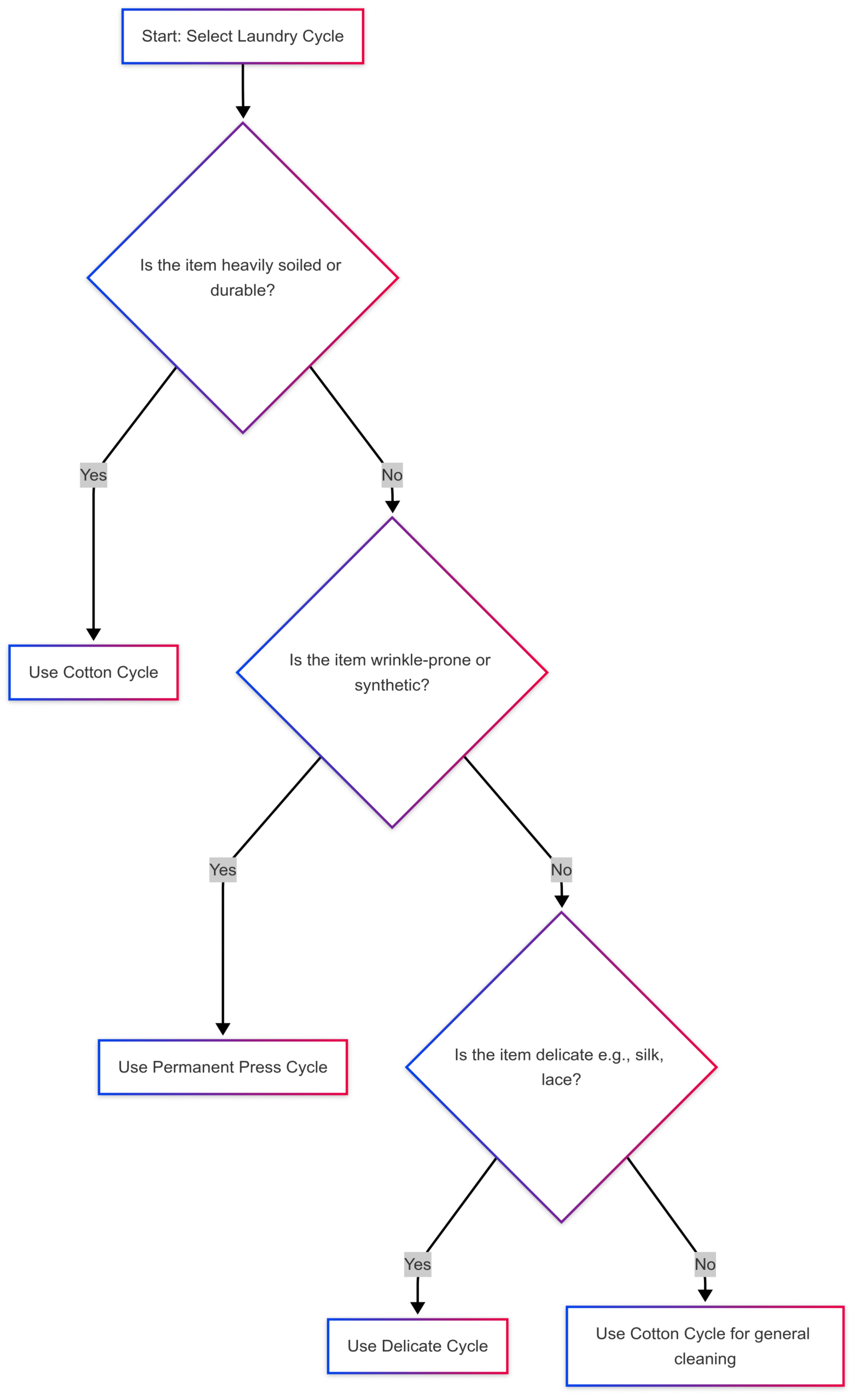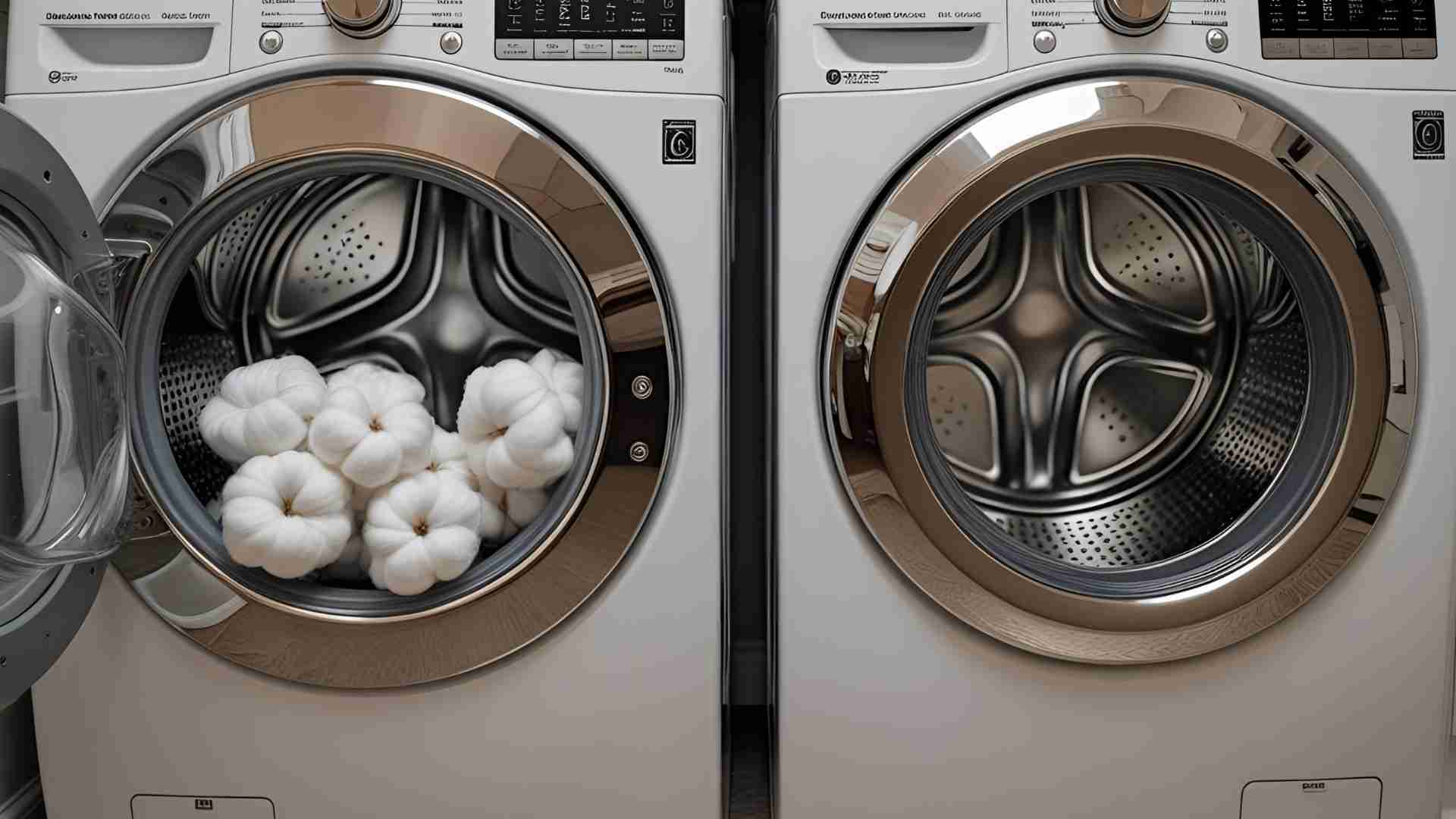Cotton Cycle Vs Permanent Press Cycle On Washer Machines
Discover the differences between Cotton Cycle and Permanent Press Cycle on washer machines, including ideal garments, temperatures, and benefits for wrinkle-free laundry.
Laundry can feel like a daunting task, especially when faced with a washer’s array of settings, temperatures, and cycle options. Choosing the wrong cycle can lead to shrunken sweaters, faded colors, or wrinkled shirts, turning a simple chore into a costly mistake. Two of the most common washer settings—Cotton Cycle and Permanent Press Cycle—are designed for distinct purposes, yet their differences are often misunderstood. This guide explores these cycles in depth, detailing their purposes, ideal garments, temperature settings, and benefits to help you optimize your laundry routine and extend the life of your clothes.
Understanding Washer Cycles: Why They Matter
Modern washing machines offer a variety of cycles tailored to different fabrics, soil levels, and care needs. Selecting the right cycle ensures your clothes are cleaned effectively while minimizing damage like shrinking, fading, or wrinkling. The Cotton Cycle (often labeled as “Regular” or “Normal”) and the Permanent Press Cycle are two staples found on most washers and dryers, each engineered to handle specific types of fabrics and laundry goals. By understanding their mechanics, you can make informed choices that keep your wardrobe looking its best.
The Importance of Care Labels
Before diving into the specifics of each cycle, it’s critical to emphasize the role of care labels. These tags, sewn into garments, provide manufacturer instructions on washing, drying, and ironing. Ignoring them can lead to irreversible damage, such as shrinking delicate fabrics or fading vibrant colors. Both the Cotton and Permanent Press cycles align with care label recommendations, so always check these tags before selecting a cycle.
What is the Cotton Cycle?
The Cotton Cycle, also known as the Regular or Normal Cycle, is designed for durable, heavy-duty fabrics that can withstand vigorous washing. This cycle is ideal for items that are either made of cotton or require thorough cleaning due to heavy soiling.
Key Features of the Cotton Cycle
- Agitation and Spin: The Cotton Cycle uses high-speed agitation and spinning to scrub out dirt and stains effectively. This robust action ensures deep cleaning but can be too harsh for delicate or wrinkle-prone fabrics.
- Cycle Duration: Typically lasts between 4 and 14 minutes for washing, though total cycle time (including rinse and spin) can range from 50 to 80 minutes, depending on the washer model and load size.
- Water Temperature:
- Hot Water: Best for white cotton garments or heavily soiled items like towels and bed linens. Hot water maximizes cleaning power but may cause shrinking or fading in some fabrics.
- Warm Water: Suitable for durable colored garments, such as jeans or sweatshirts, that don’t risk color bleeding.
- Cold Water: Recommended for brightly colored cotton items to prevent fading or running dyes.
- Rinse: Always use a cold rinse to lock in cleanliness and minimize fabric stress.
Ideal Garments for the Cotton Cycle
The Cotton Cycle is tailored for sturdy, cotton-based items or heavily soiled garments, including:
- Bed linens (sheets, comforters, pillowcases)
- Towels and washcloths
- Rugs and draperies
- Jeans and sweatshirts
- Outerwear
- Lightly soiled cotton clothing that’s exceptionally dirty (e.g., muddy athletic wear)
When to Use the Cotton Cycle
Use this cycle for items that can handle intense cleaning without risk of damage. For example, a load of white towels or heavily soiled jeans benefits from the Cotton Cycle’s powerful agitation. However, avoid this cycle for delicate fabrics or items with permanent press finishes, as the high spin speeds can cause wrinkling or wear.
Benefits of the Cotton Cycle
- Deep Cleaning: Effectively removes dirt, stains, and odors from durable fabrics.
- Energy Efficiency: When paired with warm or cold water, it balances cleaning power with energy conservation.
- Versatility: Suitable for a wide range of household linens and sturdy clothing.
What is the Permanent Press Cycle?
The Permanent Press Cycle is engineered to care for clothes that are prone to wrinkling or have a special wrinkle-resistant finish. Introduced in the 1950s to complement “permanent press” fabrics—chemically treated textiles designed to resist wrinkles—this cycle is gentler than the Cotton Cycle, prioritizing fabric preservation over aggressive cleaning.
Key Features of the Permanent Press Cycle
- Agitation and Spin: Uses moderate agitation and low spin speeds to clean clothes thoroughly without causing excessive wear or creasing. This gentle action helps maintain fabric integrity.
- Cycle Duration: Washing typically takes 4 to 12 minutes, with total cycle times ranging from 30 to 45 minutes, depending on the washer model.
- Water Temperature:
- Warm Water: Ideal for everyday soils on synthetic fabrics or wrinkle-prone natural fibers.
- Hot Water: Used for heavily soiled permanent press items or whites, though less common.
- Cold Rinse: A hallmark of the Permanent Press Cycle, the cool rinse relaxes fabrics and prevents wrinkles from setting during spinning.
- Dryer Settings: In dryers, the Permanent Press Cycle uses medium heat followed by a prolonged cool-down period to prevent creasing as clothes settle.
Ideal Garments for the Permanent Press Cycle
This cycle is perfect for everyday clothing and fabrics that require wrinkle prevention, including:
- Synthetic fabrics (polyester, nylon, rayon, acrylic)
- Cotton or linen items prone to wrinkling (e.g., button-up shirts, blouses)
- Professional attire (dresses, trousers, skirts)
- “Wrinkle-free” or “wash-and-wear” garments with permanent press finishes
- Casual clothing like T-shirts and sports shirts with normal soiling
When to Use the Permanent Press Cycle
Choose this cycle for clothes that need gentle cleaning to avoid wrinkles or preserve special finishes. It’s ideal for synthetic blends, professional wear, or natural fibers like cotton and linen that wrinkle easily. However, it’s not suitable for heavily soiled items (which require the Cotton Cycle) or delicate fabrics like silk or lace (which need the Delicate Cycle).
Benefits of the Permanent Press Cycle
- Wrinkle Reduction: Minimizes creases, reducing or eliminating the need for ironing.
- Fabric Preservation: Gentle agitation and lower temperatures protect fibers from wear, pilling, and stretching.
- Color Protection: Cool rinses help prevent fading in synthetic and colored fabrics.
- Time Efficiency: Shorter cycle times compared to the Cotton Cycle, ideal for regular laundry loads.
Comparing Cotton Cycle and Permanent Press Cycle
To clarify the differences, here’s a detailed comparison of the Cotton Cycle and Permanent Press Cycle across key parameters:
| Feature | Cotton Cycle | Permanent Press Cycle |
|---|---|---|
| Purpose | Deep cleaning for durable, heavily soiled items | Gentle cleaning with wrinkle prevention |
| Agitation | High-speed, vigorous | Moderate, gentle |
| Spin Speed | High | Low |
| Water Temperature | Hot, warm, or cold (based on garment) | Warm or hot, with cold rinse |
| Cycle Duration | 50–80 minutes (total) | 30–45 minutes (total) |
| Ideal Fabrics | Cotton, linens, denim, towels | Synthetics, wrinkle-prone cotton/linen, blends |
| Soil Level | Heavy to moderate | Moderate to light |
| Wrinkle Prevention | Minimal | High, with cool rinse and low spin |
| Energy Efficiency | Moderate (depends on water temp) | High (shorter cycle, lower temps) |
Chart: Visualizing Cycle Differences
Below is a flowchart to help decide which cycle to use based on garment type and condition:

This chart simplifies the decision-making process, ensuring you select the appropriate cycle based on fabric type and soil level.
Practical Tips for Using Cotton and Permanent Press Cycles
To maximize the effectiveness of these cycles and protect your clothes, follow these expert-backed tips:
For the Cotton Cycle
- Sort by Color and Soil Level: Separate whites, bright colors, and heavily soiled items to avoid color bleeding and ensure thorough cleaning.
- Use Appropriate Detergent: Choose a high-efficiency (HE) detergent for modern washers to optimize cleaning and reduce residue.
- Avoid Overloading: Overcrowding can reduce cleaning efficiency and strain the washer. Keep loads moderate for best results.
- Check Care Labels: Ensure items can withstand high agitation and hot water, especially for non-cotton fabrics.
For the Permanent Press Cycle
- Sort by Fabric Type: Group synthetics and wrinkle-prone natural fibers together to maximize wrinkle reduction.
- Wash Frequently: Wash permanent press items before heavy soiling occurs, as they require gentler cleaning to maintain their finish.
- Keep Loads Small: Smaller loads allow better agitation and reduce wrinkling, as clothes have more room to move.
- Remove Promptly: Take clothes out of the dryer immediately after the cycle ends to prevent wrinkles from setting.
- Mimic with Cool Cycles: If your machine lacks a Permanent Press setting, use a warm wash with a cold rinse and low spin speed to replicate the effect.
General Laundry Tips
- Read Care Labels: Always follow garment care instructions to avoid damage.
- Use Mesh Bags: For delicate permanent press items, use mesh laundry bags to reduce friction.
- Avoid Over-Drying: Excessive drying can set wrinkles or damage fibers, especially in permanent press garments.
- Maintain Your Washer: Clean your machine regularly to prevent detergent buildup, which can affect cycle performance.
How These Cycles Work in Modern Washers
Modern washing machines, such as those from Maytag, Whirlpool, and Asko, are designed with advanced sensors and customizable settings to enhance cycle performance. For example:
- Maytag Washers: Feature a “Wrinkle Control” cycle, a variant of Permanent Press, using warm water and low spin speeds to minimize creases.
- Whirlpool Washers: Offer a “Casual” cycle, similar to Permanent Press, tailored for synthetic blends and wrinkle-prone fabrics.
- Asko Washers: Provide up to 25 programs, including Normal and Permanent Press, with intuitive names for easy selection.
Example Washer Specifications
Below is a comparison of two popular washer models to illustrate how Cotton and Permanent Press cycles are implemented:
| Model | Maytag MVW7232HW | Whirlpool WFW8620HC |
|---|---|---|
| Type | Top-Load | Front-Load |
| Cotton Cycle | Normal Cycle (50–80 min, hot/warm/cold) | Normal Cycle (50–80 min, hot/warm/cold) |
| Permanent Press Cycle | Wrinkle Control (30–45 min, warm, cold rinse) | Casual Cycle (30–45 min, warm, cold rinse) |
| Spin Speeds | Up to 850 RPM | Up to 1200 RPM |
| Price (Approx.) | $999 | $1,199 |
Note: Prices vary by retailer and region. Check manufacturer websites for current pricing.
Common Misconceptions
- Permanent Press is the Same as Delicate: While both are gentler than the Cotton Cycle, the Permanent Press Cycle is designed for wrinkle prevention, whereas the Delicate Cycle is for fragile fabrics like silk or lace. Permanent Press is too aggressive for delicates.
- Cotton Cycle is Universal: Using the Cotton Cycle for all laundry can damage synthetic or wrinkle-prone fabrics, leading to creasing or wear.
- Permanent Press Prevents All Shrinking: While gentler, this cycle doesn’t guarantee no shrinking. Always follow care labels to avoid heat-related damage.
Expert Insights
Laundry experts emphasize the importance of cycle selection for garment longevity. Mary Gagliardi, Clorox’s in-house scientist, notes, “Permanent press cycles maintain fabric finishes and reduce abrasion, preserving details like cuffs and hems.” Brayden Hazlewood, an appliance expert at Rectifyhome.com, adds, “Sorting by fabric type and using the Permanent Press Cycle for synthetics can significantly reduce wrinkles, saving time on ironing.”
Conclusion
The Cotton Cycle and Permanent Press Cycle serve distinct purposes in your laundry routine. The Cotton Cycle excels at deep cleaning durable, heavily soiled items like towels and jeans, using high agitation and customizable temperatures. The Permanent Press Cycle, with its gentle agitation, warm water, and cold rinse, is ideal for wrinkle-prone fabrics like synthetics and professional attire, minimizing creases and preserving fabric finishes. By understanding their differences, sorting laundry properly, and following care labels, you can optimize your washer’s performance, extend the life of your clothes, and achieve professional-quality results at home.
Whether you’re tackling a pile of muddy jeans or refreshing your work wardrobe, choosing the right cycle makes all the difference. With this guide, you’re equipped to navigate your washer’s settings with confidence, ensuring your clothes stay vibrant, wrinkle-free, and ready to wear.
Please share this Cotton Cycle Vs Permanent Press Cycle On Washer Machines your friends and do a comment below about your feedback.
We will meet you on next article.
Until you can read, Home-made weedkillers: never mix bleach and vinegar






